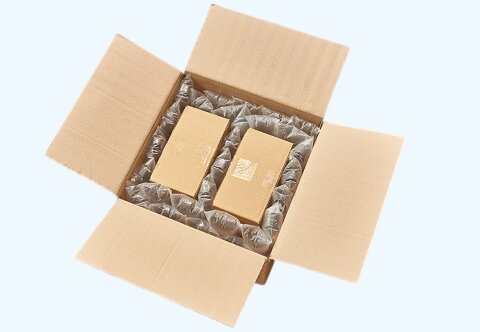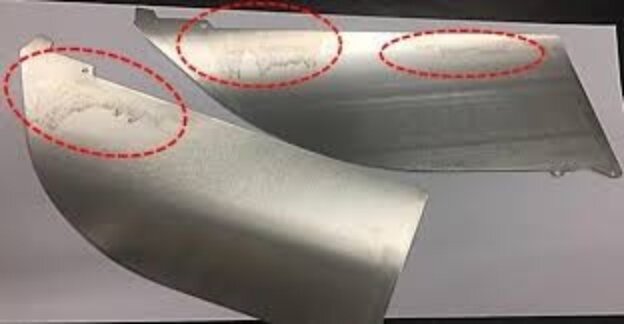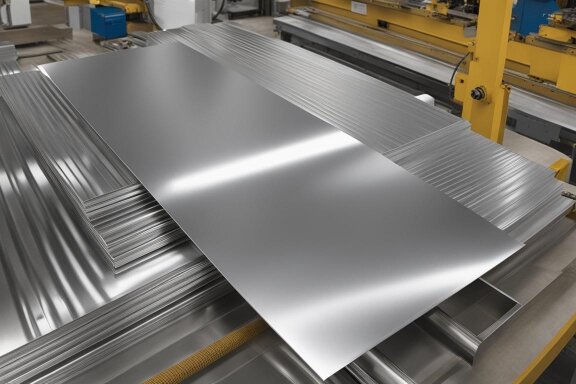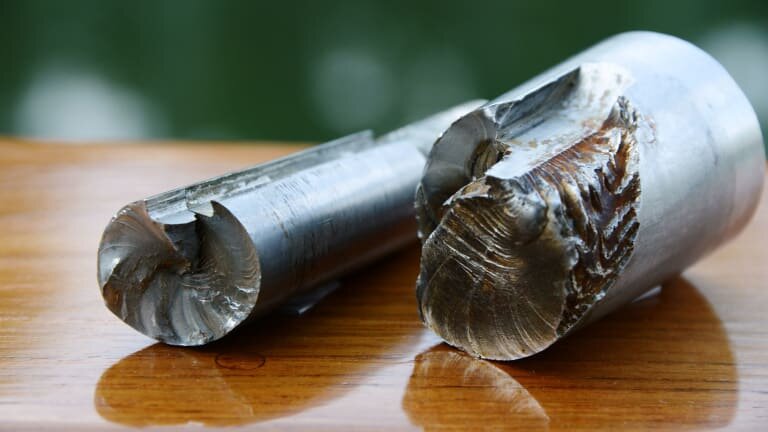Ingenieure und Konstrukteure haben oft Schwierigkeiten, ein geeignetes Metallumformungsverfahren auszuwählen, das ein Gleichgewicht zwischen Präzision, Haltbarkeit und wirtschaftlicher Machbarkeit herstellt. Die Kupferumformung ist eine bahnbrechende Lösung, die es den Herstellern ermöglicht, Rohmaterialien mit bemerkenswerter Effizienz in komplexe Hochleistungskomponenten zu verwandeln.
Dieser Blog soll die Feinheiten des Kupferstempelns verdeutlichen und sie Ingenieuren, Designern und Herstellern gleichermaßen zugänglich machen.
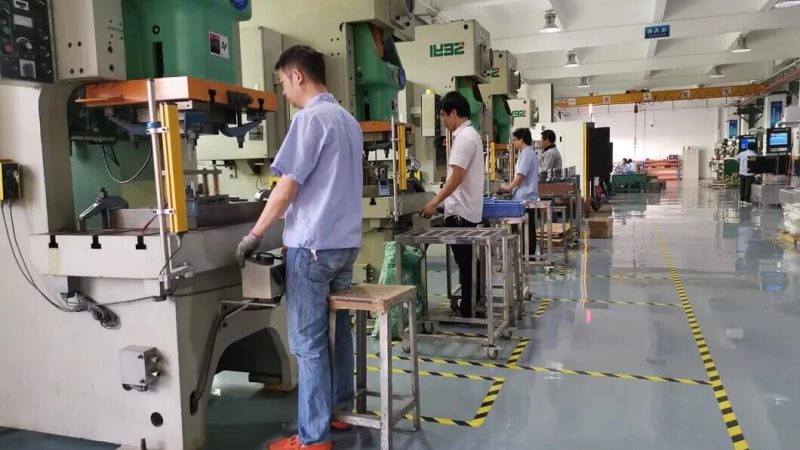
Grundlagen der Kupferstempelung
Beim Kupferstanzen handelt es sich um ein Herstellungsverfahren, bei dem Kupferbleche mit Hilfe einer mit Matrizen ausgestatteten Stanzpresse in bestimmte Formen gebracht werden. Wenn Sie die Grundlagen des Kupferstempelns verstehen, können Sie Ihre Fähigkeit, praktische Komponenten zu entwerfen und herzustellen, erheblich verbessern.
Was ist Kupferstempeln?
Das Kupferstempeln ist eine Fertigungstechnik, bei der flache Kupferbleche in komplizierte Formen und Designs verwandelt werden. Bei diesem Verfahren wird in der Regel eine Stanzpresse mit einer Matrize verwendet, die das Metall mit erheblicher Kraft formt. Diese Methode wird aufgrund der ausgezeichneten Leitfähigkeit, Flexibilität und Korrosionsbeständigkeit von Kupfer in verschiedenen Branchen eingesetzt.
Für die Stanztechnik relevante Eigenschaften von Kupfer
Kupfer verfügt über mehrere grundlegende Eigenschaften, die es für Stanzanwendungen besonders geeignet machen:
- Ausgezeichnete elektrische und thermische Leitfähigkeit: Kupfer ist bekannt für seine hervorragende Leitfähigkeit, die für elektrische Bauteile entscheidend ist.
- Formbarkeit: Kupfer lässt sich leicht formen, ohne zu brechen, so dass die Hersteller komplizierte Designs erstellen können.
- Korrosionsbeständigkeit: Kupfer entwickelt von Natur aus eine schützende Oxidschicht, die seine Korrosionsbeständigkeit erhöht.
- Duktilität: Die Fähigkeit von Kupfer, sich stark zu verformen, ohne zu brechen, ermöglicht es ihm, den Belastungen des Stanzprozesses standzuhalten.
Die Wahl des richtigen Kupfermaterials für Ihr Projekt
Bei der Auswahl des geeigneten Kupfermaterials für Ihr Stanzprojekt müssen mehrere Faktoren berücksichtigt werden:
- Anforderungen an die Bewerbung: Beurteilen Sie, ob bei Ihrem Projekt die elektrische Leitfähigkeit, die Festigkeit oder die Korrosionsbeständigkeit im Vordergrund steht.
- Umweltbedingungen: Berücksichtigen Sie die Betriebsumgebung. Wenn die Bauteile Feuchtigkeit oder Chemikalien ausgesetzt sind, kann die Verwendung einer korrosionsbeständigen Legierung von Vorteil sein.
- Herstellungsprozess: Beurteilen Sie, wie sich das gewählte Material beim Stanzen und bei nachfolgenden Prozessen wie Löten oder Schweißen.
Stanztechniken für Kupfer
Das Stanzen von Kupfer umfasst verschiedene Techniken, die auf spezifische Produktions- und Designanforderungen zugeschnitten sind. Im Folgenden werden die vier wichtigsten Stanztechniken für die Kupferherstellung vorgestellt.
Folgeschnittstanzen
Folgeschnittstanzen ist ein hocheffizientes Verfahren, bei dem eine Reihe von Werkzeugen zur Durchführung mehrerer Arbeitsgänge an einem kontinuierlichen Kupferband verwendet wird. Während sich das Metallband durch die Maschine bewegt, führt jede Matrizenstation eine bestimmte Aufgabe aus - Schneiden, Biegen oder Verformen - bis das endgültige Teil fertig ist.
Tiefziehstanzen
Tiefziehprägung ist eine Technik zur Herstellung tiefer, hohler Formen aus flachen Kupferblechen. Bei diesem Verfahren wird das Metall mit Hilfe eines Stempels in eine Matrize gezogen, die das Material streckt und in die gewünschte Form bringt.
Münzen und Prägen
Prägen und Prägen sind Stanztechniken, die erhabene oder vertiefte Motive auf Kupferoberflächen erzeugen. Beim Prägen wird hoher Druck ausgeübt, um präzise Formen oder Muster zu formen, während beim Prägen erhabene Motive entstehen, indem das Material von hinten auf das Blech gedrückt wird.
Feinschneiden für Präzisionsteile
Feinschneiden ist ein spezielles Stanzverfahren, mit dem Teile mit extrem engen Toleranzen und glatten Kanten hergestellt werden. Bei dieser Technik wird eine Stanzpresse verwendet, die eine erhebliche Kraft aufwendet, um das Metall sauber und ohne Verformung abzuscheren.
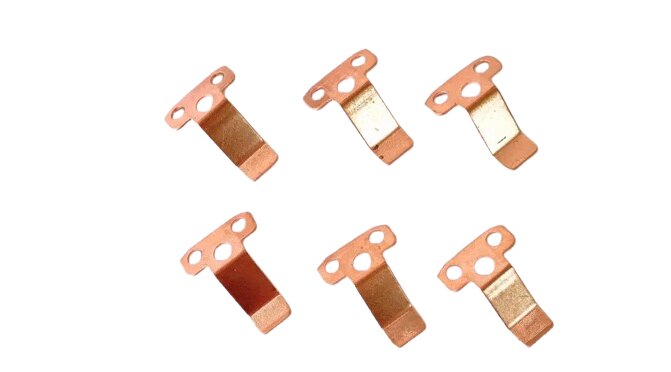
Wie man Kupfer stempelt: Eine Schritt-für-Schritt-Anleitung
Beim Kupferstanzen werden Rohmaterialien in sorgfältig geplanten Fertigungsschritten in Präzisionskomponenten umgewandelt. Jeder Schritt erfordert technisches Know-how, fortschrittliche Ausrüstung und viel Liebe zum Detail.
Materialauswahl und Vorbereitung
Die Techniker prüfen sorgfältig Materialstärke, Oberflächenqualität und metallurgische Eigenschaften. Sie reinigen und glätten Kupferbleche und entfernen Oberflächenverunreinigungen, die die Präzision beim Stanzen beeinträchtigen könnten.
Phasen des Stanzprozesses
Der Stanzvorgang umfasst mehrere kritische Phasen. Mechanische Pressen üben eine kontrollierte Kraft aus, um Kupferbleche mit Hilfe von präzise gefertigten Matrizen zu verformen. Komplexe Bauteile erfordern oft mehrere Stanzzyklen mit Zwischenglühungen, um die Duktilität des Materials zu erhalten und eine Kaltverfestigung zu verhindern.
Qualitätskontrolle und Inspektion
Strenge Qualitätskontrollmaßnahmen garantieren, dass jedes gestanzte Bauteil genau den Spezifikationen entspricht. Zur Überprüfung der Maßhaltigkeit setzen die Techniker fortschrittliche Messgeräte wie Koordinatenmessmaschinen (CMM) ein.
Werkzeuge für Kupferstempel
Die Werkzeuge sind ein entscheidender Aspekt des Kupferstempelverfahrens, da sie sich direkt auf die Qualität und Effizienz der Produktion auswirken. Dieser Abschnitt befasst sich mit Konstruktionsüberlegungen für Kupferstempel und den üblicherweise für Stanzwerkzeuge verwendeten Materialien.
Konstruktionsüberlegungen für Kupferstempel
Bei der Konstruktion von Werkzeugen für das Kupferstanzen müssen mehrere Schlüsselfaktoren berücksichtigt werden, um Leistung und Langlebigkeit zu optimieren:
- Geometrie der Matrize: Die Form und Konfiguration der Matrize sollte der vorgesehenen Konstruktion des Stanzteils entsprechen.
- Freigabe: Ein ausreichender Abstand zwischen Matrize und Stempel ist entscheidend, um übermäßige Reibung zu vermeiden, die zu Verschleiß oder Beschädigung führen kann.
- Auswahl des Materials: Die Werkstoffe der Matrizen müssen hohen Drücken standhalten, verschleißfest sein und während ihrer gesamten Lebensdauer maßhaltig bleiben.
- Wartungsfreundlichkeit: Die Konstruktion von Werkzeugen mit Blick auf die Wartung kann schnellere Reparaturen oder Anpassungen ermöglichen.
In Stanzwerkzeugen verwendete Materialien
Die Auswahl der Werkstoffe für Stanzwerkzeuge ist entscheidend für das Erreichen der gewünschten Leistungsmerkmale. Zu den gängigen Materialien, die bei der Konstruktion von Stanzwerkzeugen verwendet werden, gehören:
- Werkzeugstahl: Hochkohlenstoffhaltige und legierte Werkzeugstähle werden aufgrund ihrer hervorragenden Härte, Verschleißfestigkeit und Scharfkantigkeit häufig verwendet.
- Sinterkarbid: Es ist bekannt für seine außergewöhnliche Härte und Verschleißfestigkeit und wird häufig in Hochleistungsanwendungen eingesetzt, bei denen es auf Langlebigkeit ankommt.
- Stahlgebundenes Hartmetall: Dieser Werkstoff verbindet die Zähigkeit von Stahl mit der Härte von Hartmetall und eignet sich daher für Anwendungen, die eine hohe Festigkeit und Verschleißfestigkeit erfordern.
- Aluminiumbronze: Bei Anwendungen mit Nichteisenmetallen wie Kupfer kann Aluminiumbronze aufgrund seiner guten Antihafteigenschaften als Matrizenmaterial verwendet werden.
- Polymere Werkstoffe: In einigen Fällen werden Werkstoffe auf Polymerbasis für spezielle Anwendungen eingesetzt, bei denen eine geringere Verschleißfestigkeit akzeptabel ist, aber Gewichtseinsparungen erwünscht sind.
Kupferstempeln: Pro und Kontra
Das Kupferstanzen ist ein weit verbreitetes Herstellungsverfahren, das zahlreiche Vorteile bietet, aber auch einige Nachteile hat. Die Kenntnis dieser Vor- und Nachteile kann den Herstellern bei der Entscheidung helfen, ob das Kupferstempeln für ihre Projekte geeignet ist.
Pro
- Ausgezeichnete elektrische Leitfähigkeit: Kupfer ist für seine überragende elektrische Leitfähigkeit bekannt und daher die ideale Wahl für Anwendungen in der Elektronik, im Automobilbau und in elektrischen Systemen.
- Korrosionsbeständigkeit: Die natürliche Korrosionsbeständigkeit des Kupfers verlängert die Lebensdauer von Stanzteilen.
- Formbarkeit und Duktilität: Kupfer lässt sich leicht in komplizierte Formen bringen, ohne zu brechen.
- Ästhetische Anziehungskraft: Der warme Farbton und der natürliche Glanz von Kupfer verleihen den Produkten einen besonderen ästhetischen Wert.
Nachteile
- Hohe anfängliche Werkzeugkosten: Die Herstellung von kundenspezifischen Matrizen und Werkzeugen für das Kupferstanzen kann teuer sein.
- Eingeschränkte Eignung für kleine Chargen: Die mit der Werkzeugherstellung verbundenen Kosten können die Vorteile bei kleinen Losen oder der Produktion von Einzelstücken überwiegen.
- Einschränkungen der Präzision: Das Kupferstanzen ermöglicht zwar komplizierte Entwürfe, aber die Einhaltung sehr enger Toleranzen kann eine Herausforderung sein.
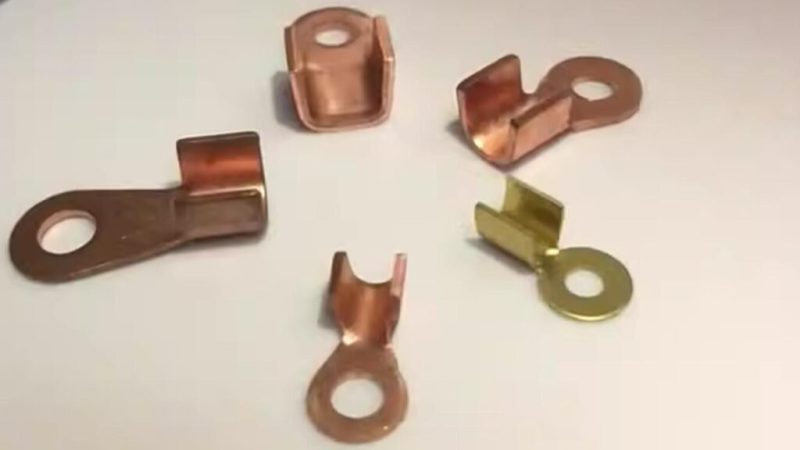
Anwendungen von Kupferstempeln
Das Kupferstanzen ist ein vielseitiges Herstellungsverfahren, das in einer Vielzahl von Branchen eingesetzt wird. Hier sehen wir uns die wichtigsten Anwendungen des Kupferstempelns in verschiedenen Bereichen an.
Elektronik- und Elektroindustrie
In der Elektronik- und Elektroindustrie ist das Stanzen von Kupfer entscheidend für die Herstellung von Komponenten, die eine hohe elektrische Leitfähigkeit und Zuverlässigkeit erfordern. Zu den üblichen Anwendungen gehören:
- Steckverbinder und Anschlussklemmen
- Temperatur fällt
- Schalter und Relais
- Leiterplatten
Anwendungen in der Automobilindustrie und der Luft- und Raumfahrt
Auch in der Automobil- und Luft- und Raumfahrtindustrie ist das Kupferstempeln nicht wegzudenken, da es zur Herstellung von Bauteilen verwendet wird, die anspruchsvollen Bedingungen standhalten müssen. Zu den wichtigsten Anwendungen gehören:
- Elektrische Systeme
- Steckverbinder und Verkabelung
- Wärmetauscher
- Komponenten für die Luft- und Raumfahrt
Industrie- und Konsumgüter
Das Kupferstempeln ist bei der Herstellung von Industriekomponenten und Konsumgütern weit verbreitet. Zu den bemerkenswerten Anwendungen gehören:
- Sanitärarmaturen
- Architektonische Merkmale
- Medizinische Geräte
- Unterhaltungselektronik
Schlussfolgerung
Das Kupferstanzen stellt einen Höhepunkt der modernen Fertigungstechnologie dar und verbindet innovatives Design mit präziser technischer Ausführung. Dieses anspruchsvolle Verfahren verwandelt Kupferrohmaterialien in Hochleistungskomponenten und treibt den technologischen Fortschritt in zahlreichen Branchen voran.
Hey, ich bin Kevin Lee

In den letzten 10 Jahren bin ich in verschiedene Formen der Blechbearbeitung eingetaucht und teile hier coole Erkenntnisse aus meinen Erfahrungen in verschiedenen Werkstätten.
Kontakt aufnehmen

Kevin Lee
Ich verfüge über mehr als zehn Jahre Berufserfahrung in der Blechverarbeitung und bin auf Laserschneiden, Biegen, Schweißen und Oberflächenbehandlungstechniken spezialisiert. Als Technischer Direktor bei Shengen bin ich bestrebt, komplexe Fertigungsherausforderungen zu lösen und Innovation und Qualität in jedem Projekt voranzutreiben.

